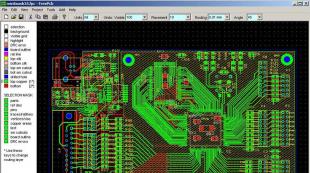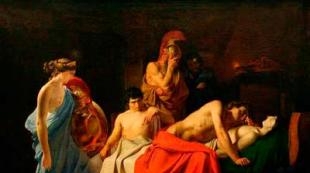Determination of the number of cells seeded on dense nutrient media (Koch's plate method). The works of R. Koch and their significance for microbiology and infectious pathology Isolation of a pure culture of aerobes Microbiology
The main stages in the development of microbiology, virology and immunology
These include the following:
1.empirical knowledge(before the invention of microscopes and their use to study the microworld).
J. Fracastoro (1546) suggested the living nature of agents of infectious diseases - contagium vivum.
2.Morphological period took about two hundred years.
Anthony van Leeuwenhoek in 1675 first described protozoa, in 1683 - the main forms of bacteria. The imperfection of instruments (the maximum magnification of X300 microscopes) and methods for studying the microworld did not contribute to the rapid accumulation of scientific knowledge about microorganisms.
3.Physiological period(since 1875) - the era of L. Pasteur and R. Koch.
L. Pasteur - the study of the microbiological foundations of the processes of fermentation and decay, the development of industrial microbiology, the elucidation of the role of microorganisms in the circulation of substances in nature, the discovery anaerobic microorganisms, development of principles asepsis, methods sterilization, attenuation ( attenuation)virulence and receiving vaccines (vaccine strains).
R. Koch - selection method pure cultures on solid nutrient media, methods of staining bacteria with aniline dyes, the discovery of anthrax, cholera ( Koch's comma), tuberculosis (Koch sticks), improvement of microscopy techniques. Experimental substantiation of the Henle criteria, known as the postulates (triad) of Henle-Koch.
4.immunological period.
I.I. Mechnikov is a “poet of microbiology” according to the figurative definition of Emil Roux. He created a new era in microbiology - the doctrine of immunity (immunity), having developed the theory of phagocytosis and substantiating the cellular theory of immunity.
At the same time, data were accumulated on the production in the body antibodies against bacteria and their toxins which allowed P. Erlich to develop the humoral theory of immunity. In the subsequent long-term and fruitful discussion between supporters of phagocytic and humoral theories, many mechanisms of immunity were revealed and science was born. immunology.
Later it was found that hereditary and acquired immunity depends on the coordinated activity of five main systems: macrophages, complement, T- and B-lymphocytes, interferons, the main histocompatibility system, providing various forms of immune response. I.I. Mechnikov and P. Erlich in 1908. was awarded the Nobel Prize.
February 12, 1892 at a meeting of the Russian Academy of Sciences, D.I. Ivanovsky reported that the causative agent of tobacco mosaic disease is a filterable virus. This date can be considered a birthday virology, and D.I. Ivanovsky - its founder. Subsequently, it turned out that viruses cause diseases not only in plants, but also in humans, animals, and even bacteria. However, only after establishing the nature of the gene and the genetic code, the viruses were classified as wildlife.
5. The next important step in the development of microbiology was discovery of antibiotics. In 1929 A. Fleming discovered penicillin and the era of antibiotic therapy began, which led to the revolutionary progress of medicine. Later it turned out that microbes adapt to antibiotics, and the study of the mechanisms of drug resistance led to the discovery of a second extrachromosomal (plasmid) genome bacteria.
Studying plasmid showed that they are even simpler organisms than viruses, and unlike bacteriophages do not harm bacteria, but endow them with additional biological properties. The discovery of plasmids significantly supplemented the ideas about the forms of existence of life and possible ways of its evolution.
6. Modern molecular genetic stage development of microbiology, virology and immunology began in the second half of the 20th century in connection with the achievements of genetics and molecular biology, the creation of the electron microscope.
In experiments on bacteria, the role of DNA in the transmission of hereditary traits was proven. The use of bacteria, viruses, and later plasmids as objects of molecular biological and genetic research led to a deeper understanding of the fundamental processes underlying life. Elucidation of the principles of encoding genetic information in the DNA of bacteria and the establishment of the universality of the genetic code made it possible to better understand the molecular genetic patterns inherent in more highly organized organisms.
The deciphering of the Escherichia coli genome has made it possible to construct and transplant genes. By now Genetic Engineering created new directions biotechnology.
The molecular genetic organization of many viruses and the mechanisms of their interaction with cells have been deciphered, the ability of viral DNA to integrate into the genome of a sensitive cell and the main mechanisms of viral carcinogenesis have been established.
Immunology has undergone a real revolution, going far beyond infectious immunology and becoming one of the most important fundamental medical and biological disciplines. To date, immunology is a science that studies not only protection against infections. In the modern sense Immunology is a science that studies the mechanisms of self-defense of the body from everything genetically alien, maintaining the structural and functional integrity of the body.
Immunology currently includes a number of specialized areas, among which, along with infectious immunology, the most significant include immunogenetics, immunomorphology, transplantation immunology, immunopathology, immunohematology, oncoimmunology, ontogenesis immunology, vaccinology and applied immunodiagnostics.
Microbiology and virology as fundamental biological sciences also include a number of independent scientific disciplines with their own goals and objectives: general, technical (industrial), agricultural, veterinary and most important for humanity medical microbiology and virology.
Medical microbiology and virology studies pathogens of human infectious diseases (their morphology, physiology, ecology, biological and genetic characteristics), develops methods for their cultivation and identification, specific methods for their diagnosis, treatment and prevention.
The Koch method is used to determine the total number of bacteria. In an empty sterile Petri dish, pour 1 ml of the test material from the appropriate dilution and pour 10 - 15 ml of molten and cooled to 45 0 C MPA, mix with the liquid, rotating the cup on the surface of the table.
After cultivating the crops, the colonies grown on the surface and in the depth of the agar are counted. To do this, the cup is placed upside down on a black background, each counted colony is marked with a marker on the glass. Evaluate only those dishes, which grew from 30 to 300 colonies. If more than 300 colonies have grown on the dish, and the analysis cannot be repeated, then colonies can be counted under strong side lighting using a magnifying glass and a special plate with a grid.
The number of colonies is counted in at least 20 squares of 1 cm 2 in different places of the dish. The average number of colonies in 1 cm 2 is calculated, which is multiplied by the area of \u200b\u200bthe dish.
When counting colonies, a special bacterial counting device, PSB, can be used.
The result of counting colonies in each dish is the number of bacteria per 1 ml (cm 3) or 1 g of the test material, taking into account dilution. For the final number of bacteria, the arithmetic mean of the results of counting colonies on plates with inoculation of two adjacent dilutions is taken.
Example: breeding 10 -1 - 250 colonies, breeding 10 -2 - 23 colonies.
Total number of bacteria = 250 x 10 + 23 x 100 / 2 = 2400 cfu / ml = 2.4 x 10 2 cfu / ml (colony forming units per 1 ml).
The result of the research can be rounded up to 2 - 3 significant figures.
Titration method.
Used to determine the number of PSDs.
1st stage: material homogenization. If necessary, preparation of a suspension in order to transfer microorganisms into a liquid phase.
2nd stage: preparation of a series of dilutions.
3rd stage: inoculation of selected volumes of the test material (100, 10, 1 ml) and its 1 ml dilutions into a liquid nutrient medium. To improve the accuracy of the method, each volume can be sown in parallel in several portions of the nutrient medium (two-, three-, five-row sowing). Optimal is a threefold repetition (sufficient reliability at a relatively low cost).
4th stage: taking into account the presence of growth on a liquid nutrient medium and seeding from positive volumes on a solid nutrient medium.
5th stage: identification of microorganisms grown on solid nutrient medium. At the same time, cultural properties are taken into account and, if necessary, additional studies are carried out (study of tinctorial, morphological, biochemical and serological properties).
If a single row method is used, the result is usually expressed as the titer of the target microorganism, which is taken as the smallest volume (highest dilution) in which it was still found.
If a multi-row method was used, the results are recorded using special tables that allow, based on the combination of positive volumes that gave rise, to determine the titer, index (MP).
Special environments.
In bacteriology, dry nutrient media of industrial production are widely used, which are hygroscopic powders containing all components of the medium, except water. For their preparation, tryptic digests of cheap non-food products (fish waste, meat and bone meal, technical casein) are used. They are convenient for transportation, can be stored for a long time, save laboratories from the enormous process of preparing media, and bring the issue of standardization of media closer to resolution. The medical industry produces dry media of Endo, Levin, Ploskirev, bismuth sulfite agar, nutrient agar, carbohydrates with BP indicator and others.
thermostats
Thermostats are used for cultivating microorganisms.
A thermostat is a device that maintains a constant temperature. The device consists of a heater, a chamber, double walls between which air or water circulates. The temperature is controlled by a thermostat. The optimum temperature for the reproduction of most microorganisms is 37°C.
ACTIVITY 7
TOPIC: METHODS FOR ISOLATION OF A PURE AEROBIC CULTURE. STAGES OF ISOLATION OF A PURE CULTURE OF AEROBIC BACTERIA BY THE METHOD OF MECHANICAL UNCOUPLING
Lesson plan
1. The concept of "pure culture" of bacteria
2. Methods for isolating pure cultures by mechanical separation
3. Biological methods for isolating pure cultures
4. Methods for identifying bacteria
Purpose of the lesson: To acquaint students with various methods for isolating pure cultures, to teach how to do crops with a loop, strokes, prick
Guidelines for the demonstration
In their natural habitat, bacteria are found in associations. In order to determine the properties of microbes, their role in the development of the pathological process, it is necessary to have bacteria in the form of homogeneous populations (pure cultures). A pure culture is a collection of bacterial individuals of the same species grown on a nutrient medium.
Methods for isolating pure cultures of aerobic bacteria
Pasteur Method Koch Method Biological Physical
(has historical (plate wiring)
Meaning)
Chemical Method
Shchukevich
![]() Modern
Modern
Sowing with a loop Sowing with a spatula
(Drigalski method)
Methods for isolating pure cultures:
1. Methods of mechanical separation are based on the separation of microbes by successive rubbing of the test material over the surface of the agar.
a) Pasteur's method - is of historical importance, provides for the sequential dilution of the test material in a liquid nutrient medium by the rolling method
b) The Koch method - the method of plate layouts - is based on the sequential dilution of the test material with meat-peptone agar, followed by pouring test tubes with diluted material into Petri dishes.
c) Drygalski's method - when sowing material abundantly seeded with microflora, use 2-3 cups for successive sowing with a spatula.
d) Sowing with a loop in parallel strokes.
2. Biological methods are based on the biological properties of pathogens.
a) Biological - infection of highly sensitive animals, where microbes rapidly multiply and accumulate. In some cases, this method is the only one that allows you to isolate the culture of the pathogen from a sick person (for example, with tularemia), in other cases it is more sensitive (for example, the isolation of pneumococcus in white mice or the causative agent of tuberculosis in guinea pigs).
b) Chemical - based on the acid resistance of mycobacteria. To free the material from accompanying flora, it
treated with an acid solution. Only tubercle bacilli will grow, as the acid-tolerant microbes are killed by the acid.
c) The physical method is based on the resistance of spores to heat. To isolate cultures of spore-forming bacteria from
mixtures, the material is heated at 80°C and inoculated on a nutrient medium. Only spore bacteria will grow, because their spores remained alive and gave growth.
d) Shukevich's method - based on the high mobility of the vulgar proteus, capable of creeping growth.
Agar Plate Preparation Method
MPA is melted in a water bath, then cooled to 50-55°C. The neck of the vial is burned in the flame of an alcohol lamp, the Petri dishes are opened so that the neck of the vials enters, without touching the edges of the dish, pour out 10-15 ml of MPA, close the lid, shake the dish so that the medium is evenly distributed, leave it on a horizontal surface until solidified. After drying, plates with plate agar are stored in the cold.
Loop sowing
A drop of material is taken with a sterile cooled loop, one edge of the cup is slightly opened with the left hand, a loop is inserted inside and a few strokes are made at the opposite edge in one place, then the loop is torn off and the material is inoculated with parallel strokes from one edge of the cup to another with an interval of 5-6 mm. At the beginning of sowing, when there will be a lot of microbes on the loop, they will give confluent growth, but with each stroke of the microbes on the loop, there will be less and less microbes, and they will remain solitary and give isolated colonies.
Sowing according to the Drygalski method
This method is used when sowing material abundantly seeded with microflora (pus, feces, sputum). For sowing according to the Drygalsky method, a spatula and several cups (3-4) are taken. A spatula is a tool made of metal wire or glass dart, bent in the form of a triangle or L-shaped. The material is introduced into the first cup with a loop or pipette and evenly distributed with a spatula over the surface of the medium, with the same spatula, without burning it, the material is rubbed into the nutrient medium in the second cup, and then in the third. With this inoculation, the first plate will have confluent growth, and isolated colonies will grow in subsequent plates.
Relatively few methods are known for isolating bacteria as pure cultures. This is most commonly done by isolating single cells on solid growth media using the streak-inoculation method or by pouring a small amount of liquid culture into plates ( dilution method). However, obtaining a separate colony does not always guarantee the purity of the culture, since colonies can grow not only from individual cells, but also from their clusters. If microorganisms form mucus, then foreign forms often attach to it. For cleaning, it is preferable to use a non-selective medium (MPA) because contaminants grow better on it and are easier to detect.
Obtaining isolated colonies on a solid nutrient medium is achieved either by sieving a suspension of microorganisms with a spatula ( Koch method), or with the help of a bacteriological loop ( debilitating stroke method). As a result of mechanical separation of microbial cells, each of them can give rise to an isolated colony of one microbial species.
Sieving with a spatula (Koch method) produced in the following sequence:
1) a drop of the enrichment culture is applied to the surface of the nutrient medium in cup No. 1 with a sterile pipette and distributed with a sterile spatula;
2) the spatula is taken out, the cup is quickly closed and the spatula is transferred to cup No. 2 without sterilizing it. Simulate the distribution of the culture over the entire surface of the medium by touching its surface with the same side of the spatula that was previously used to distribute the sample;
3) exactly the same actions are carried out in cup No. 3, after which the spatula is sterilized;
4) seeded cups are placed in a thermostat and incubated at the optimum temperature.
After a certain time, the cups are removed from the thermostat and the growth of microorganisms is studied. Usually, a continuous growth of bacteria is observed in dish No. 1, colonies are noted in subsequent dishes.
Loop sieving (depleting stroke method) involves inoculation of a bacteriological loop from an enrichment culture onto the surface of an agar medium in Petri dishes. At the first stage, a loop with the culture is applied with a series of parallel strokes on the agar medium (Figure 4.2, A). The loop is sterilized, cooled on the uninoculated part of the agar medium and a series of strokes is drawn in the direction perpendicular to the first (Figure 4.2, B). Then the loop is sterilized again, cooled and strokes are applied in the direction IN(Figure 4.2), and after the next sterilization - in the direction G(Figure 4.2). The cups are placed in a thermostat and after a certain time the results are taken into account. Usually on strokes A And B a large number of colonies grow (sometimes continuous growth), while on the strokes IN And G isolated colonies are formed.
Figure 4.2 - Scheme of sieving bacteria with strokes to obtain isolated colonies
Serial dilutions in solid media- the simplest method of plate inoculation, which consists in the fact that after inoculating the sample into a test tube with sterile melted and cooled agar, the medium is mixed, poured into a Petri dish and allowed to solidify. To obtain well-isolated colonies, a series of successive ten-fold dilutions is prepared and 1 ml of samples are added immediately to the dish, 15–20 ml of molten agar medium are added and mixed by shaking the dish. Sometimes individual colonies are immersed in agar and can only be removed mechanically. It is also bad that the bacteria are in the medium at the temperature of molten agar for some time.
If, on the basis of certain symptoms on the plants and the results of microscopic examination, it is suspected that the causative agent of the disease is a bacterium, the next step should be to isolate it.
In this case, it is assumed that the pathogen is contaminated with associated organisms, i.e., there is a mixed population. To obtain the pathogen as a separate growing colony, the tissue macerate should be streaked onto the medium.
Stroke sowing. With a calcined inoculation loop, a small amount of plant tissue macerate containing bacteria is taken and with light movements, without damaging the surface of the agar, is applied to the prepared nutrient medium with 4-6 strokes. Having re-ignited the loop, the cup with the medium is turned 90 ° to the right and then 4-6 more strokes are applied from the second stroke, the needle is re-ignited and the third inoculation is carried out. This achieves such a dilution of the starting material, in which the bacteria, after incubation in a thermostat for 48-72 hours at 28 ° C, form separate colonies of various shapes and colors. The colonies are then transferred for further study into slant agar tubes. A colony is taken with a calcined loop and, with a careful movement in the form of a snake or zigzag, is applied to nutrient agar.
Koch pouring method. The Koch pouring method ensures that each colony is formed from a single bacterial cell. It is best to suspend the starting material in sterile water and apply the Koch method only with this dilution. A small amount of the suspension is transferred into the first test tube with a nutrient medium cooled to 60 °C. Then the contents of the tube are mixed with the inoculum by rotating it between the palms. Next, take the second test tube, carefully open it over the flame of the burner and transfer three portions of the substrate into it from the first test tube with large loops. The contents of the test tube after firing the neck and stopper are poured into the first Petri dish, slightly opening the lid of the cup just enough to insert the neck of the test tube under it. Immediately after pouring, the cup is closed and the nutrient medium is evenly distributed with careful movements.
After thoroughly mixing the contents of the second test tube, take the third test tube and transfer six portions of the substrate into it with a loop from the second. The contents of the test tube are poured into a cup, and the contents of the test tube, after mixing, are poured into a cup. Cups with the medium are incubated in a thermostat at 28°C, after a few days the bacteria contained in the starting material form colonies.
Serial breeding. If, for example, it is necessary to isolate bacteria from the soil, then serial dilution is used. Sterile nutrient medium (15 ml per dish) is poured into dishes, 0.1 ml of the last three dilutions of the suspension are applied to the hardened agar and spread over the surface with a glass spatula.
To isolate bacteria, 1 g of soil is suspended in 9 ml of water, shaken well, allowed to stand for a few seconds, and serial dilutions are prepared from the suspension. With this method, the number of microorganisms in each sample can be determined.
If you find an error, please highlight a piece of text and click Ctrl+Enter.









